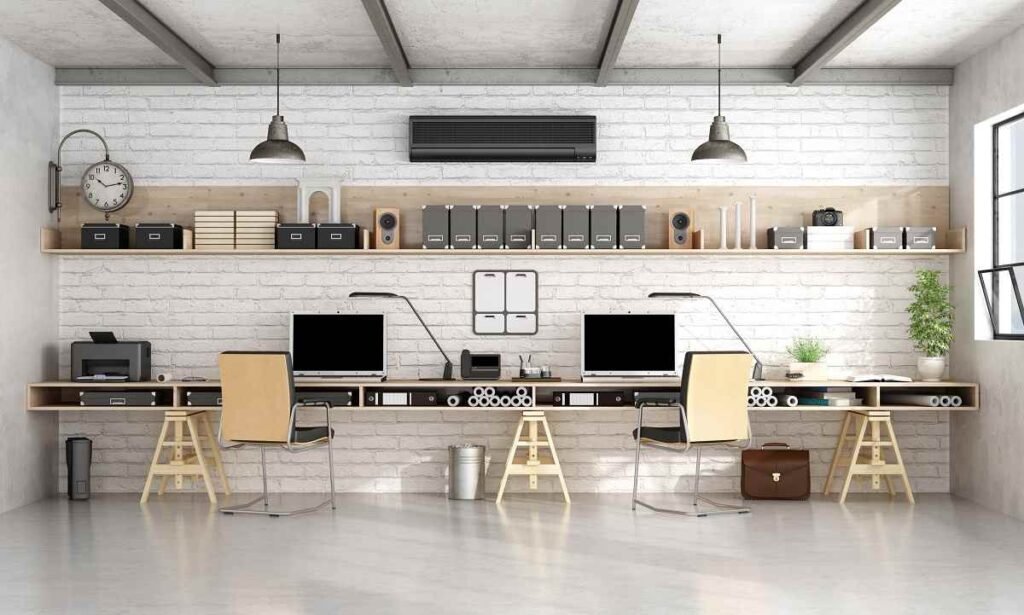Office cleaning plays a crucial role in reducing allergens and improving air quality, creating a healthier work environment. Dust, mold, and bacteria can easily accumulate in office spaces, affecting air quality and triggering allergies. Regular cleaning, especially when handled by professionals like Radiant Clean Maintenance, helps eliminate these allergens, keeping the air fresh and breathable. With routine cleaning, surfaces, carpets, and HVAC systems are maintained, preventing the buildup of harmful particles. This leads to improved productivity, fewer sick days, and overall well-being for employees, making office cleaning an essential part of a thriving workplace.
In today’s modern workplaces, the health and well-being of employees are a top priority. As companies focus on improving productivity, employee satisfaction, and overall workplace environment, one important factor is often overlooked: air quality. Poor air quality can have a significant impact on employee health, leading to allergies, respiratory issues, and decreased productivity. One of the most effective ways to combat this problem is through regular office cleaning.
This article will explore how office cleaning plays a crucial role in reducing allergens and improving air quality. We’ll look at the sources of common allergens in the office, the benefits of routine cleaning, and how professional cleaning services like Radiant Clean Maintenance can help create a healthier, more productive work environment.
What Are Common Allergens Found in Offices?

Common allergens found in offices include dust, mold, pet dander, pollen, and bacteria. Dust can accumulate on surfaces, carpets, and furniture, while mold grows in damp areas. Pet dander and pollen often enter through open windows or on clothing. Bacteria can spread through high-touch areas like doorknobs and phones. Regular office cleaning services help reduce these allergens by disinfecting surfaces, vacuuming carpets, and maintaining ventilation systems. This helps create a cleaner, healthier workspace for employees, reducing allergic reactions and improving air quality.
Before delving into the benefits of office cleaning, it’s important to understand the types of allergens commonly found in office spaces. Allergens are substances that can trigger allergic reactions in sensitive individuals, causing symptoms like sneezing, coughing, itchy eyes, and even more severe respiratory problems. Common allergens in the office include:
1. Dust
Dust is one of the most prevalent allergens in any office environment. It consists of tiny particles that settle on surfaces such as desks, furniture, and floors. Dust is made up of a variety of substances, including dead skin cells, dirt, pollen, mold spores, and tiny insects. Over time, dust accumulates in office spaces, especially in corners, behind furniture, and on top of shelves.
2. Mold
Mold grows in damp, humid environments, and many office buildings can become breeding grounds for mold, especially in areas with poor ventilation or water damage. Mold spores are a common allergen, and they can easily spread through the air, causing respiratory problems, asthma flare-ups, and allergic reactions. Mold growth in areas like bathrooms, kitchens, or basements is particularly common, but it can also develop in hidden places such as behind walls or under carpets.
3. Pollen
While pollen is more commonly associated with outdoor environments, it can also enter offices through open windows, vents, and on clothing. In areas with a lot of plants or during peak allergy seasons, pollen levels can be high, and this can lead to discomfort for employees with sensitivities.
4. Pet Dander
Many offices allow employees to bring their pets to work, or sometimes pets can be present in the building in some capacity (such as in nearby residential areas). Pet dander—tiny flakes of skin shed by animals—is a common allergen. It can cling to furniture, carpets, and even the air, triggering allergic reactions in people who are sensitive to it.
5. Bacteria and Viruses
While not allergens in the traditional sense, bacteria and viruses can have a significant impact on air quality. High-touch areas like doorknobs, keyboards, and phones can harbor germs that spread through the air and cause illnesses like colds, the flu, and other respiratory infections.
6. Volatile Organic Compounds (VOCs)
Many office cleaning products, as well as materials such as furniture and carpeting, can release VOCs into the air. VOCs are chemicals that can evaporate and mix with the air, leading to poor indoor air quality. These chemicals can cause headaches, dizziness, and irritation of the eyes, nose, and throat.
How Does Office Cleaning Reduce Allergens?

Office cleaning reduces allergens by regularly removing dust, mold, pet dander, and other particles that accumulate on surfaces and in carpets. Routine cleaning, including vacuuming with HEPA filters and wiping down surfaces, helps prevent allergens from circulating in the air. Deep cleaning services go a step further by thoroughly cleaning hard-to-reach areas, such as air vents, upholstery, and carpets, ensuring that even hidden allergens are removed. This creates a healthier office environment, improving air quality and employee well-being.
Now that we’ve established the types of allergens that can affect air quality in the office, let’s look at how regular office cleaning helps mitigate these issues. Cleaning your office doesn’t just mean tidying up; it’s about addressing the specific causes of poor air quality and taking steps to minimize allergens.
1. Dusting and Vacuuming
Dust is one of the most common allergens found in any office, and regular cleaning can drastically reduce its presence. Dusting surfaces such as desks, tables, and shelves helps prevent dust from accumulating and spreading through the air. Vacuuming carpets and floors is also essential, as it picks up the dust and other particles that have settled into the fibers. Professional cleaning services like Radiant Clean Maintenance use high-quality vacuum cleaners with HEPA filters, which are capable of capturing even the smallest dust particles, improving indoor air quality.
2. Cleaning Air Ducts and HVAC Systems
The heating, ventilation, and air conditioning (HVAC) system plays a significant role in circulating air throughout the office. If the ducts are clogged with dust, dirt, and mold, they can contribute to poor air quality and the spread of allergens. Regular cleaning of air ducts helps to remove debris and mold spores, reducing the presence of allergens in the air. Changing filters frequently is another key step in improving air quality, and this should be part of any professional office cleaning routine.
3. Dealing with Mold and Moisture
Mold thrives in damp environments, so eliminating moisture is critical in preventing mold growth. Professional cleaners know where to look for hidden sources of moisture, such as behind appliances or under sinks, and can take steps to address them. Regular cleaning of areas prone to moisture—such as bathrooms, kitchens, and basements—helps prevent mold from taking hold. If mold is already present, professional cleaners can take steps to remove it safely, which will improve the air quality and reduce allergy symptoms.
4. Removing Pet Dander
Pet dander can linger in an office for long periods, even if the pet is no longer present. Cleaning areas where pets frequent, such as pet-friendly offices or spaces near open windows, is essential to reduce pet dander levels. Vacuuming with specialized pet dander filters and wiping down surfaces where dander may settle can significantly improve air quality for those with pet allergies.
5. Using Green Cleaning Products
Many cleaning products contain harsh chemicals that can release volatile organic compounds (VOCs) into the air. These compounds can worsen air quality and trigger allergic reactions. By switching to eco-friendly cleaning products, which are free from harmful chemicals, office cleaning can be made safer and more effective. Radiant Clean Maintenance uses environmentally friendly cleaning products that are not only effective at reducing allergens but also safe for employees and the environment.
6. Cleaning High-Touch Areas
Cleaning high-touch areas, such as doorknobs, light switches, phones, and elevator buttons, is essential for maintaining a clean and healthy office environment. Regular cleaning of these surfaces helps reduce the spread of germs and bacteria, improving overall air quality and preventing illness. Additionally, window cleaning services are equally important, as clean windows not only enhance the office’s appearance but also allow more natural light in, contributing to better air quality and a more inviting workspace for employees and clients alike.
High-touch areas like doorknobs, elevator buttons, light switches, and phones can become hotspots for germs, bacteria, and viruses. Regular cleaning of these areas reduces the spread of illness-causing germs, which in turn improves air quality by reducing the number of airborne pathogens. This can help reduce sick days, improve employee health, and create a cleaner, healthier workplace.
FAQs
How to improve air quality in the office?
To improve air quality in the office, regularly clean surfaces and carpets to reduce dust and allergens. Maintain HVAC systems by cleaning air ducts and replacing filters to ensure proper ventilation. Incorporate plants and use eco-friendly cleaning products to naturally purify the air and minimize harmful chemicals.
How to improve office ventilation?
To improve office ventilation, ensure that HVAC systems are regularly serviced and filters are replaced to maintain clean airflow. Open windows when possible to allow fresh air in, especially in areas with high foot traffic. Consider using air purifiers and fans to enhance air circulation and reduce indoor pollutants.
How can we keep air quality clean?
To keep air quality clean, regularly clean and vacuum surfaces to reduce dust and allergens. Use air purifiers with HEPA filters and maintain proper ventilation through open windows or HVAC systems. Avoid using harsh chemicals and opt for eco-friendly cleaning products to prevent VOCs from contaminating indoor air.
How to keep office air clean?
To keep office air clean, regularly clean surfaces, floors, and air vents to reduce dust and allergens. Use air purifiers with HEPA filters to remove particles and improve air quality. Ensure proper ventilation by opening windows when possible or maintaining an efficient HVAC system.
How to purify air at the office?
To purify air at the office, invest in air purifiers with HEPA filters to capture dust, allergens, and particles. Increase ventilation by opening windows or ensuring the HVAC system is regularly maintained and properly filtered. Introduce indoor plants that naturally help filter and improve air quality by absorbing toxins and releasing oxygen.
Conclusion
Maintaining a clean office is more than just aesthetic; it’s essential for creating a healthy, productive work environment. Regular office cleaning helps reduce allergens like dust, mold, and pet dander, leading to improved air quality. This not only benefits employee health but also boosts morale and productivity. With the help of a professional cleaning service like Radiant Clean Maintenance, you can ensure that your office remains clean, safe, and free from harmful allergens that could affect your team. Prioritizing air quality through office cleaning is an investment in both the well-being of your employees and the success of your business.
